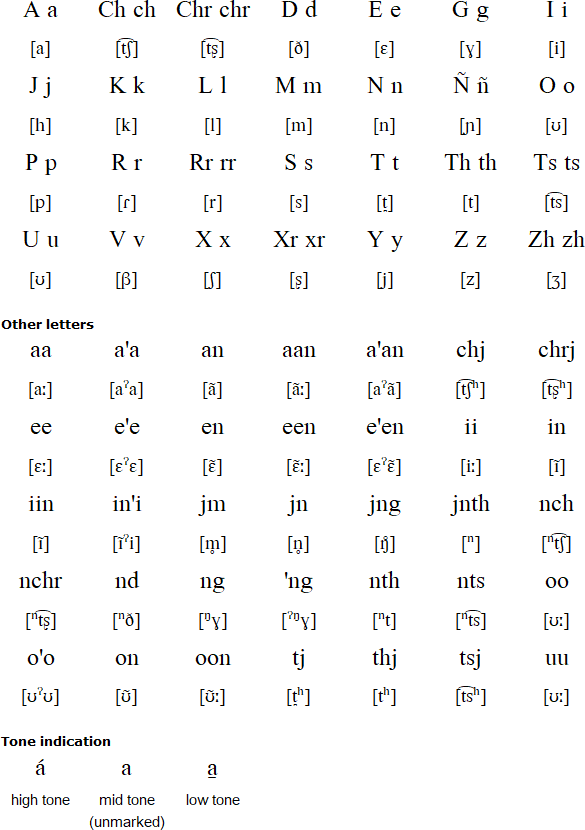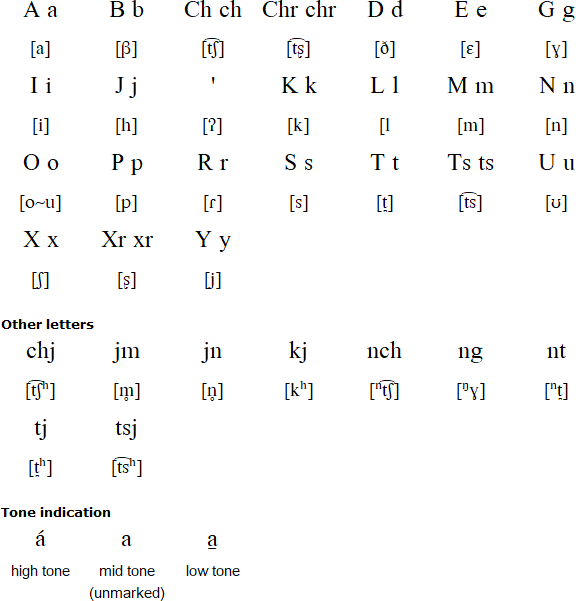Northern Popoloca is a member of the Popolocan branch of the Oto-Manguean language family. It is spoken by about 13,000 people in the state of Puebla in southern Mexico. In particular, it is spoken in the towns of San Luís Temalacayuca and San Marcos Tlacoyalco in the east of Puebla.
The varieties of Northern Popoloca spoken in each town differ from each other enough that they are considered separate languages by some, although they are around 90% mutually intelligible. The variety spoken in San Marcos Tlacoyalco is known as Northern Popoloca, Popoloca de San Marcos Tlalcoyalco, Popoluca del norte or San Marcos Tlalcoyalco Popoloca. Native speakers call it Ngiiwa̱ or Ngigua. The variety spoken in San Luís Temalacayuca is known as San Luís Temalacayuca Popoloca or Popoloca de San Luís Temalacayuca, and native speakers call it Ngigua.
A way to write San Marcos Tlalcoyalco Popoloca with the Latin script was developed in 1947, and a new alphabet was introduced in 2005. San Luís Temalacayuca Popoloca also got an alphabet in 2005. The 2005 alphabets are shown below.


Download alphabet charts for Northern Popoloca (Excel) - some details provided by Michael Peter Füstumum
Ngigua nichja chujni San Marcos Tlacoyalco, kai di'in popoloca. Ko San Marcos Tlacoyalco jii ngain nunthe Ndani'nga (Puebla), nu nunthexin (sureste) ngain nunthe Sasenthjua, ko jii inchin noo kan kilómetro nu ku'e (norte) rajna Ndachjian ko inchin inkjaon kilómetro nu sureste ngain municipio Xula Benito Juárez. Ko icha ni nichja xraje'o ngigua kai te na rajnanchja di'in San José Buenavista, kai te na tuenjna ngain rajnanchjan di'in: Piedra Incada, Palo Verde, San Juan Sacabasco, San Martín Esperilla, Ni'ngo Joon, Sompantle ko San Francisco Esperilla. Ko rajna icha jié, mee rajna San Marcos Tlacoyalco. Ko ngigua ji'i kai binchegi'in na̱ popoloca de norte. Ko ni ngigua Tlacoyalco jii inchin kan ko the no̱ (30,000) na̱.
The language spoken in San Marcos Tlacoyalco belongs to the Popoloca family. San Marcos Tlacoyalco is located in the state of Puebla, in southern Mexico, approximately 40 kilometers north of Tehuacán and 6 kilometers southeast of the municipality of Tlacotepec de Juárez. The same variant is spoken in the neighboring town of San José Buenavista, and in a high valley on the other side of the mountain east of San Marcos. The towns in that valley are Piedra Incada, Palo Verde, San Juan Sacabasco, San Martín Esperilla, Sopantle, and San Francisco Esperilla. Speakers of this language call it Ngigua, and it has also been designated as Northern Popoloca. Approximately 30,000 people speak this variant. Most of them live in San Marcos.
Source: https://www.popoloca-tlacoyalco.com/pls/thi-jindajin-rajna
Kaín chu̱jni tunkji'i ni ya'i ku̱ chúnda'a ni najníi̱ ni kaín ni jían rúgayee ni dereecho. Chúnda na juaṟixaun ku̱ juaxrexingaon ku̱ chúnda na ke̱ sakau na chuu na ínchin nindu'e na.
All human beings are born free and equal in dignity and rights. They are endowed with reason and conscience and should act towards one another in a spirit of brotherhood.
(Article 1 of the Universal Declaration of Human Rights)
Ngigua tjajna San Luis Temalcayuca, jii ngaxi'in itsje mil ngigua nichjani nguixin nunte xasintajni, maski bakjin'ani ngigua, jai o chao xrokjinni ngigua ko jii ngaxin libro tsikoña ngigua. Icha see ngigua ji'i chao bakjin sen ngigua ko xranchi xrontachroni konko nge'e. Ngigua nichjana tikinixin naa ntaa tin'in otomangue, ntaa me'e chunda inko yaato ngigua.
Ngigua (or Popoloca) of San Luis Temalacayuca is one of the thousands of languages spoken in the world. Although it was not written for many years, books are currently written and published in Ngigua. However, long before then, this language already had its own grammar, which includes nouns, verbs, adjectives, pronouns, adverbs, etc.
Source: https://www.ngiguatemalacayuca.org/es/cerca-del-ngigua
Information about Northern Popoloca
https://en.wikipedia.org/wiki/Northern_Popoloca_language/
https://ru.wikipedia.org/wiki/Севернопополокский_язык
https://www.sil.org/resources/search/language/pls
https://www.popoloca-tlacoyalco.com/es/gram%C3%A1tica-1
https://www.ngiguatemalacayuca.org/es/página-de-inicio
https://www.popoloca-tlacoyalco.com/es/bienvenidos-0
http://www.language-archives.org/language/pls
Chinanteco, Chatino, Mazahua, Mazatec, Mazatec (Chiquihuitlán), Mazatec (Jalapa), Mixtec, Mixtec (Chayuco), Mixtec (Coatzospan), Otomi, Otomi (Acazulco), Otomi (Sierra), Otomi (Temoaya), Popoloca (Northern), Tlapanec, Triqui (Chicahuaxtla), Triqui (Copala), Triqui (San Martín Itunyos), Triqui (Santo Domingo del Estero), Zapotec (Aloápam), Zapotec (Choápam), Zapotec (Güilá), Zapotec (Isthmus), Zapotec (Miahuatlán), Zapotec (Rincón), Zapotec (San Dionisio Ocotepec), Zapotec (Zoogocho)
Languages written with the Latin alphabet
Page created: 12.09.25. Last modified: 12.09.25
[top]
You can support this site by Buying Me A Coffee, and if you like what you see on this page, you can use the buttons below to share it with people you know.

If you like this site and find it useful, you can support it by making a donation via PayPal or Patreon, or by contributing in other ways. Omniglot is how I make my living.
Note: all links on this site to Amazon.com, Amazon.co.uk
and Amazon.fr
are affiliate links. This means I earn a commission if you click on any of them and buy something. So by clicking on these links you can help to support this site.
[top]